Effective Management: Trust and Transparency in Healthcare
VerifiedAdded on 2020/06/04
|13
|3484
|42
Essay
AI Summary
This essay delves into the critical importance of trust and transparency within healthcare organizations, examining their impact on effective leadership and management. It highlights how building trust is a two-way process involving both leaders and employees, crucial for fostering open communication and a positive work environment. The essay explores the significance of transparency in various aspects, including problem-solving, team building, and authentic relationships, leading to higher performance levels. It discusses practical ways to implement transparency, such as open communication and providing timely feedback. Furthermore, the essay emphasizes the importance of trust and transparency in healthcare, highlighting the benefits for patient satisfaction and effective patient-physician relationships. It provides real-world examples and discusses barriers to effective leadership, offering strategies for creating a transparent and safe culture within healthcare settings. The essay underscores the need for healthcare leaders to prioritize communication, address mistakes openly, and empower patients through transparency, ultimately leading to improved patient outcomes and organizational success. The essay concludes by stressing the importance of transparency for building brand loyalty and fostering a culture of continuous improvement within healthcare organizations.
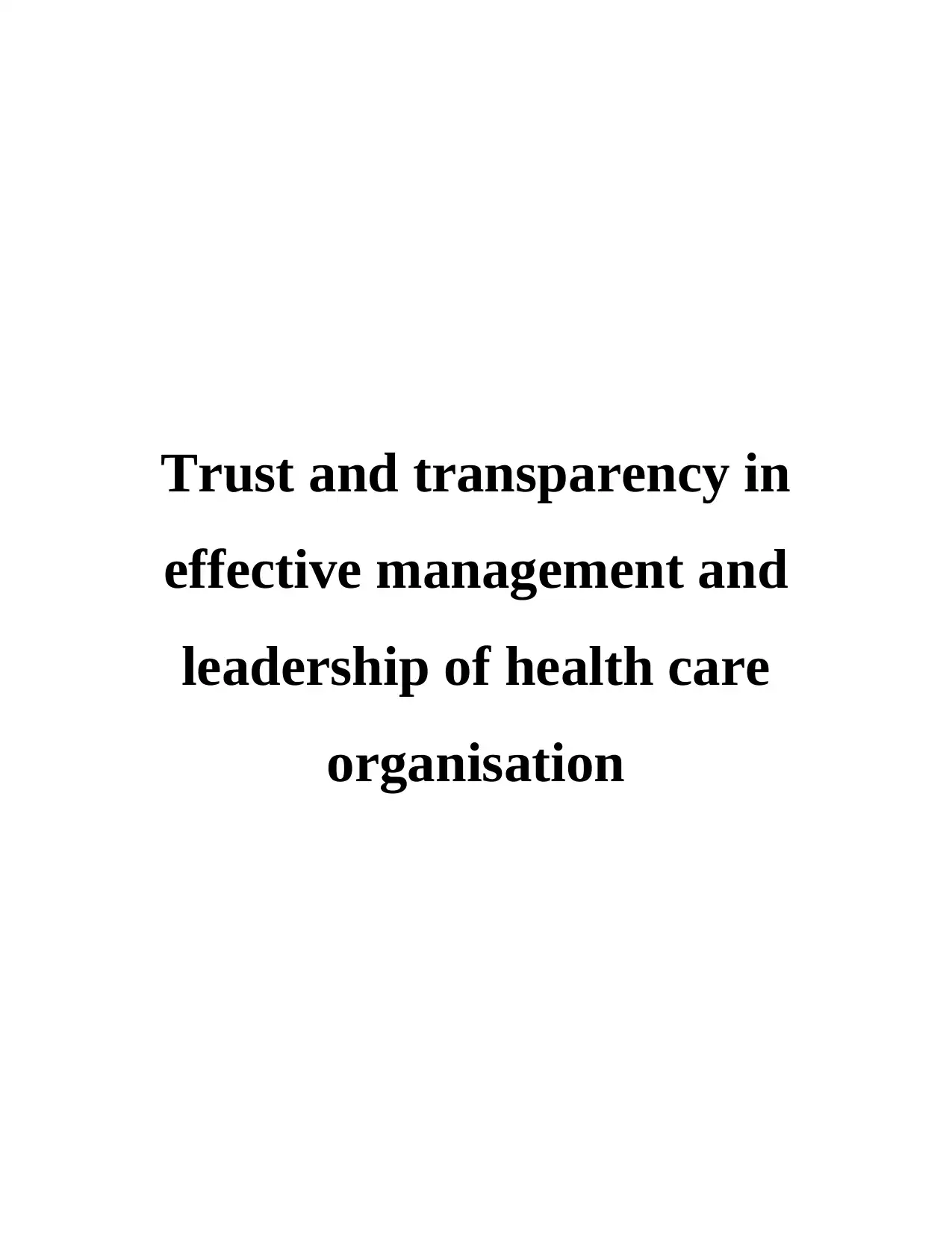
Trust and transparency in
effective management and
leadership of health care
organisation
effective management and
leadership of health care
organisation
Paraphrase This Document
Need a fresh take? Get an instant paraphrase of this document with our AI Paraphraser
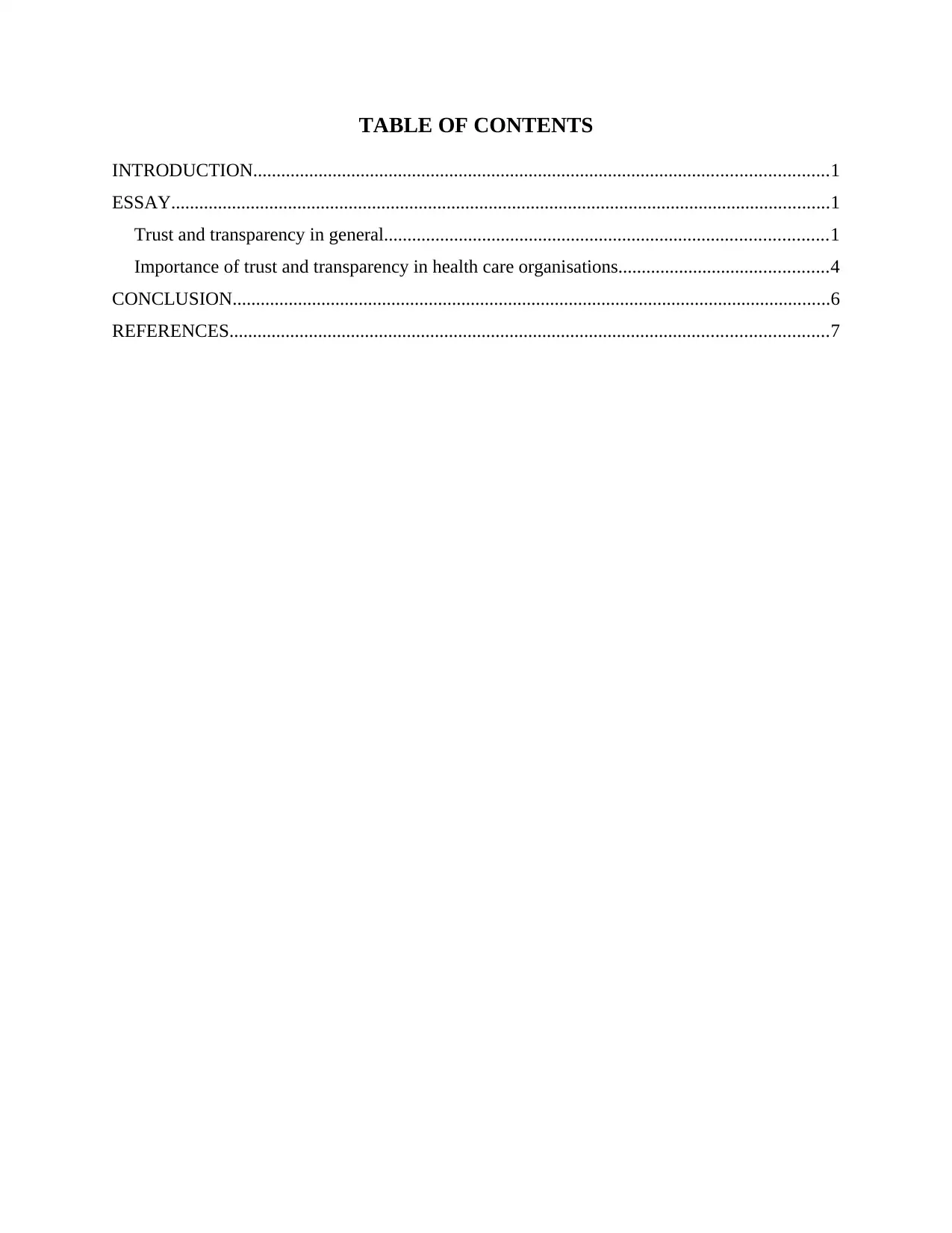
TABLE OF CONTENTS
INTRODUCTION...........................................................................................................................1
ESSAY.............................................................................................................................................1
Trust and transparency in general...............................................................................................1
Importance of trust and transparency in health care organisations.............................................4
CONCLUSION................................................................................................................................6
REFERENCES................................................................................................................................7
INTRODUCTION...........................................................................................................................1
ESSAY.............................................................................................................................................1
Trust and transparency in general...............................................................................................1
Importance of trust and transparency in health care organisations.............................................4
CONCLUSION................................................................................................................................6
REFERENCES................................................................................................................................7
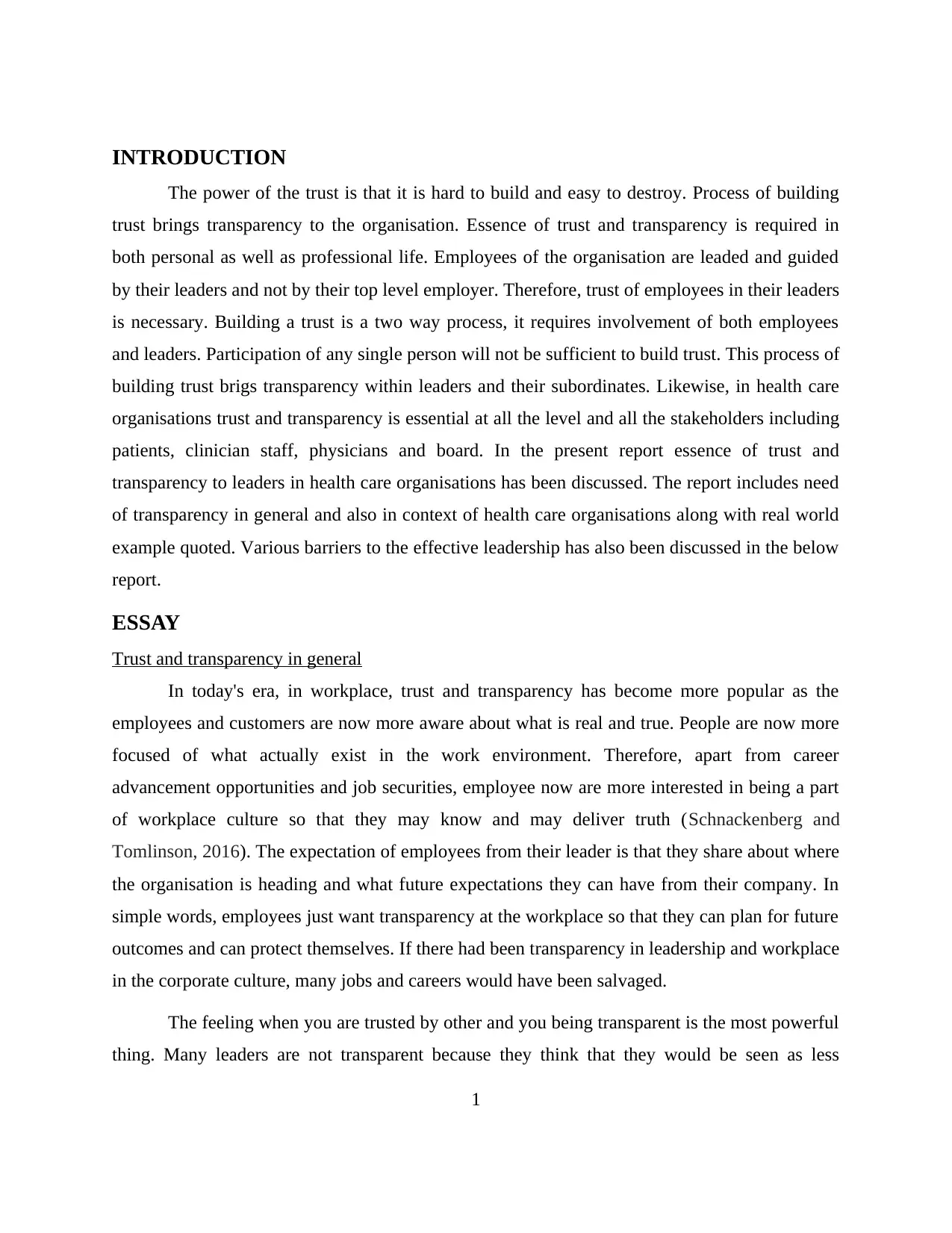
INTRODUCTION
The power of the trust is that it is hard to build and easy to destroy. Process of building
trust brings transparency to the organisation. Essence of trust and transparency is required in
both personal as well as professional life. Employees of the organisation are leaded and guided
by their leaders and not by their top level employer. Therefore, trust of employees in their leaders
is necessary. Building a trust is a two way process, it requires involvement of both employees
and leaders. Participation of any single person will not be sufficient to build trust. This process of
building trust brigs transparency within leaders and their subordinates. Likewise, in health care
organisations trust and transparency is essential at all the level and all the stakeholders including
patients, clinician staff, physicians and board. In the present report essence of trust and
transparency to leaders in health care organisations has been discussed. The report includes need
of transparency in general and also in context of health care organisations along with real world
example quoted. Various barriers to the effective leadership has also been discussed in the below
report.
ESSAY
Trust and transparency in general
In today's era, in workplace, trust and transparency has become more popular as the
employees and customers are now more aware about what is real and true. People are now more
focused of what actually exist in the work environment. Therefore, apart from career
advancement opportunities and job securities, employee now are more interested in being a part
of workplace culture so that they may know and may deliver truth (Schnackenberg and
Tomlinson, 2016). The expectation of employees from their leader is that they share about where
the organisation is heading and what future expectations they can have from their company. In
simple words, employees just want transparency at the workplace so that they can plan for future
outcomes and can protect themselves. If there had been transparency in leadership and workplace
in the corporate culture, many jobs and careers would have been salvaged.
The feeling when you are trusted by other and you being transparent is the most powerful
thing. Many leaders are not transparent because they think that they would be seen as less
1
The power of the trust is that it is hard to build and easy to destroy. Process of building
trust brings transparency to the organisation. Essence of trust and transparency is required in
both personal as well as professional life. Employees of the organisation are leaded and guided
by their leaders and not by their top level employer. Therefore, trust of employees in their leaders
is necessary. Building a trust is a two way process, it requires involvement of both employees
and leaders. Participation of any single person will not be sufficient to build trust. This process of
building trust brigs transparency within leaders and their subordinates. Likewise, in health care
organisations trust and transparency is essential at all the level and all the stakeholders including
patients, clinician staff, physicians and board. In the present report essence of trust and
transparency to leaders in health care organisations has been discussed. The report includes need
of transparency in general and also in context of health care organisations along with real world
example quoted. Various barriers to the effective leadership has also been discussed in the below
report.
ESSAY
Trust and transparency in general
In today's era, in workplace, trust and transparency has become more popular as the
employees and customers are now more aware about what is real and true. People are now more
focused of what actually exist in the work environment. Therefore, apart from career
advancement opportunities and job securities, employee now are more interested in being a part
of workplace culture so that they may know and may deliver truth (Schnackenberg and
Tomlinson, 2016). The expectation of employees from their leader is that they share about where
the organisation is heading and what future expectations they can have from their company. In
simple words, employees just want transparency at the workplace so that they can plan for future
outcomes and can protect themselves. If there had been transparency in leadership and workplace
in the corporate culture, many jobs and careers would have been salvaged.
The feeling when you are trusted by other and you being transparent is the most powerful
thing. Many leaders are not transparent because they think that they would be seen as less
1
⊘ This is a preview!⊘
Do you want full access?
Subscribe today to unlock all pages.

Trusted by 1+ million students worldwide
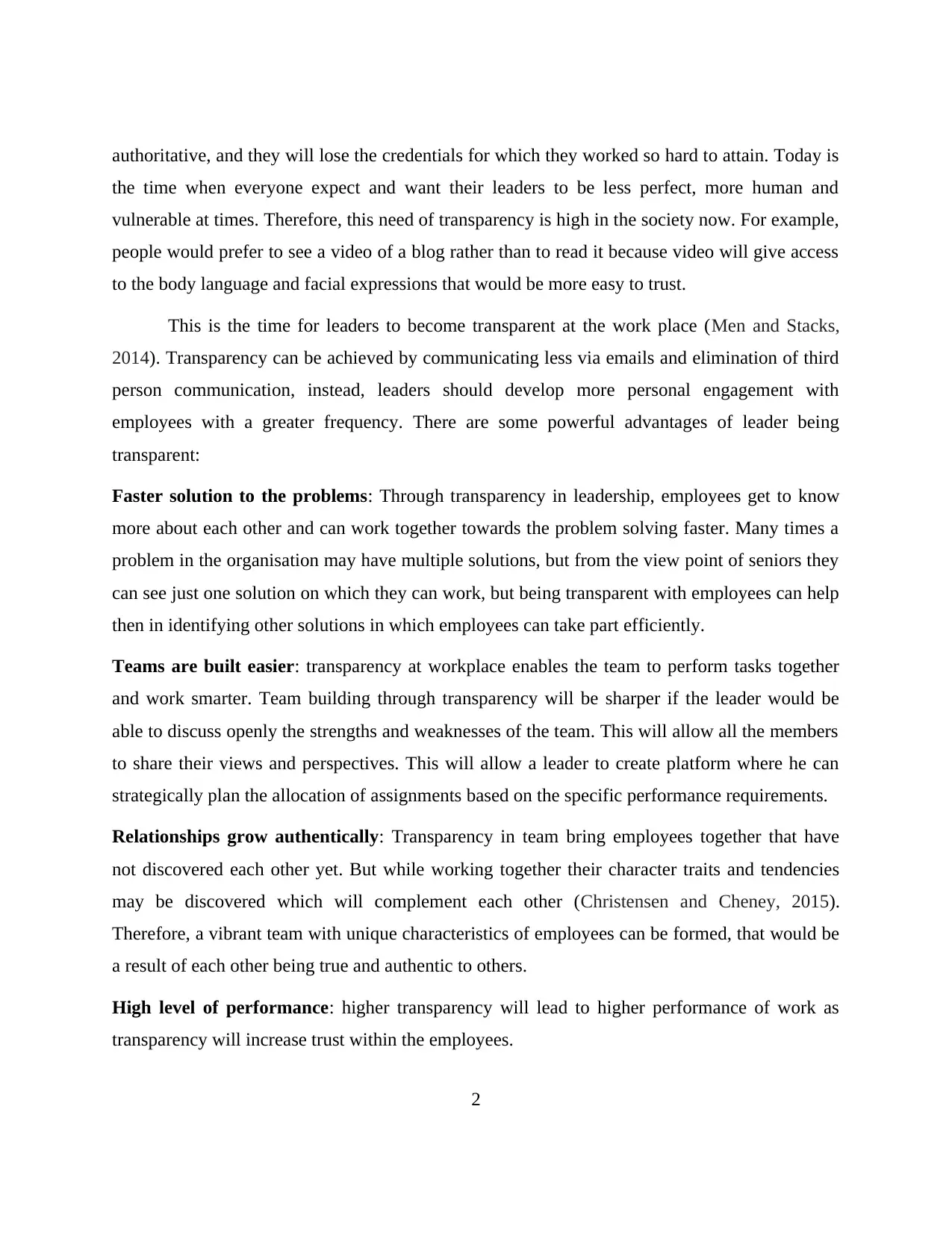
authoritative, and they will lose the credentials for which they worked so hard to attain. Today is
the time when everyone expect and want their leaders to be less perfect, more human and
vulnerable at times. Therefore, this need of transparency is high in the society now. For example,
people would prefer to see a video of a blog rather than to read it because video will give access
to the body language and facial expressions that would be more easy to trust.
This is the time for leaders to become transparent at the work place (Men and Stacks,
2014). Transparency can be achieved by communicating less via emails and elimination of third
person communication, instead, leaders should develop more personal engagement with
employees with a greater frequency. There are some powerful advantages of leader being
transparent:
Faster solution to the problems: Through transparency in leadership, employees get to know
more about each other and can work together towards the problem solving faster. Many times a
problem in the organisation may have multiple solutions, but from the view point of seniors they
can see just one solution on which they can work, but being transparent with employees can help
then in identifying other solutions in which employees can take part efficiently.
Teams are built easier: transparency at workplace enables the team to perform tasks together
and work smarter. Team building through transparency will be sharper if the leader would be
able to discuss openly the strengths and weaknesses of the team. This will allow all the members
to share their views and perspectives. This will allow a leader to create platform where he can
strategically plan the allocation of assignments based on the specific performance requirements.
Relationships grow authentically: Transparency in team bring employees together that have
not discovered each other yet. But while working together their character traits and tendencies
may be discovered which will complement each other (Christensen and Cheney, 2015).
Therefore, a vibrant team with unique characteristics of employees can be formed, that would be
a result of each other being true and authentic to others.
High level of performance: higher transparency will lead to higher performance of work as
transparency will increase trust within the employees.
2
the time when everyone expect and want their leaders to be less perfect, more human and
vulnerable at times. Therefore, this need of transparency is high in the society now. For example,
people would prefer to see a video of a blog rather than to read it because video will give access
to the body language and facial expressions that would be more easy to trust.
This is the time for leaders to become transparent at the work place (Men and Stacks,
2014). Transparency can be achieved by communicating less via emails and elimination of third
person communication, instead, leaders should develop more personal engagement with
employees with a greater frequency. There are some powerful advantages of leader being
transparent:
Faster solution to the problems: Through transparency in leadership, employees get to know
more about each other and can work together towards the problem solving faster. Many times a
problem in the organisation may have multiple solutions, but from the view point of seniors they
can see just one solution on which they can work, but being transparent with employees can help
then in identifying other solutions in which employees can take part efficiently.
Teams are built easier: transparency at workplace enables the team to perform tasks together
and work smarter. Team building through transparency will be sharper if the leader would be
able to discuss openly the strengths and weaknesses of the team. This will allow all the members
to share their views and perspectives. This will allow a leader to create platform where he can
strategically plan the allocation of assignments based on the specific performance requirements.
Relationships grow authentically: Transparency in team bring employees together that have
not discovered each other yet. But while working together their character traits and tendencies
may be discovered which will complement each other (Christensen and Cheney, 2015).
Therefore, a vibrant team with unique characteristics of employees can be formed, that would be
a result of each other being true and authentic to others.
High level of performance: higher transparency will lead to higher performance of work as
transparency will increase trust within the employees.
2
Paraphrase This Document
Need a fresh take? Get an instant paraphrase of this document with our AI Paraphraser
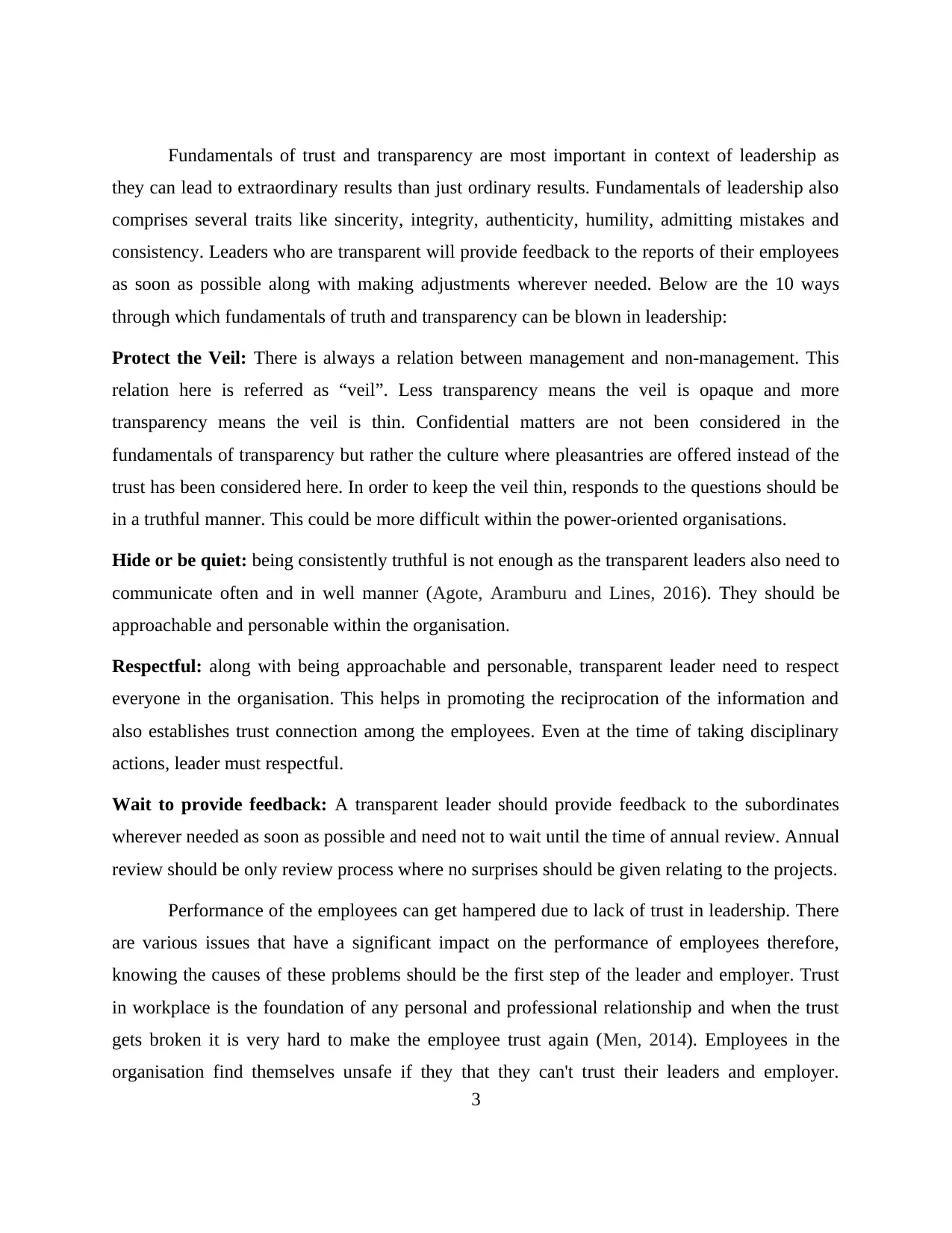
Fundamentals of trust and transparency are most important in context of leadership as
they can lead to extraordinary results than just ordinary results. Fundamentals of leadership also
comprises several traits like sincerity, integrity, authenticity, humility, admitting mistakes and
consistency. Leaders who are transparent will provide feedback to the reports of their employees
as soon as possible along with making adjustments wherever needed. Below are the 10 ways
through which fundamentals of truth and transparency can be blown in leadership:
Protect the Veil: There is always a relation between management and non-management. This
relation here is referred as “veil”. Less transparency means the veil is opaque and more
transparency means the veil is thin. Confidential matters are not been considered in the
fundamentals of transparency but rather the culture where pleasantries are offered instead of the
trust has been considered here. In order to keep the veil thin, responds to the questions should be
in a truthful manner. This could be more difficult within the power-oriented organisations.
Hide or be quiet: being consistently truthful is not enough as the transparent leaders also need to
communicate often and in well manner (Agote, Aramburu and Lines, 2016). They should be
approachable and personable within the organisation.
Respectful: along with being approachable and personable, transparent leader need to respect
everyone in the organisation. This helps in promoting the reciprocation of the information and
also establishes trust connection among the employees. Even at the time of taking disciplinary
actions, leader must respectful.
Wait to provide feedback: A transparent leader should provide feedback to the subordinates
wherever needed as soon as possible and need not to wait until the time of annual review. Annual
review should be only review process where no surprises should be given relating to the projects.
Performance of the employees can get hampered due to lack of trust in leadership. There
are various issues that have a significant impact on the performance of employees therefore,
knowing the causes of these problems should be the first step of the leader and employer. Trust
in workplace is the foundation of any personal and professional relationship and when the trust
gets broken it is very hard to make the employee trust again (Men, 2014). Employees in the
organisation find themselves unsafe if they that they can't trust their leaders and employer.
3
they can lead to extraordinary results than just ordinary results. Fundamentals of leadership also
comprises several traits like sincerity, integrity, authenticity, humility, admitting mistakes and
consistency. Leaders who are transparent will provide feedback to the reports of their employees
as soon as possible along with making adjustments wherever needed. Below are the 10 ways
through which fundamentals of truth and transparency can be blown in leadership:
Protect the Veil: There is always a relation between management and non-management. This
relation here is referred as “veil”. Less transparency means the veil is opaque and more
transparency means the veil is thin. Confidential matters are not been considered in the
fundamentals of transparency but rather the culture where pleasantries are offered instead of the
trust has been considered here. In order to keep the veil thin, responds to the questions should be
in a truthful manner. This could be more difficult within the power-oriented organisations.
Hide or be quiet: being consistently truthful is not enough as the transparent leaders also need to
communicate often and in well manner (Agote, Aramburu and Lines, 2016). They should be
approachable and personable within the organisation.
Respectful: along with being approachable and personable, transparent leader need to respect
everyone in the organisation. This helps in promoting the reciprocation of the information and
also establishes trust connection among the employees. Even at the time of taking disciplinary
actions, leader must respectful.
Wait to provide feedback: A transparent leader should provide feedback to the subordinates
wherever needed as soon as possible and need not to wait until the time of annual review. Annual
review should be only review process where no surprises should be given relating to the projects.
Performance of the employees can get hampered due to lack of trust in leadership. There
are various issues that have a significant impact on the performance of employees therefore,
knowing the causes of these problems should be the first step of the leader and employer. Trust
in workplace is the foundation of any personal and professional relationship and when the trust
gets broken it is very hard to make the employee trust again (Men, 2014). Employees in the
organisation find themselves unsafe if they that they can't trust their leaders and employer.
3
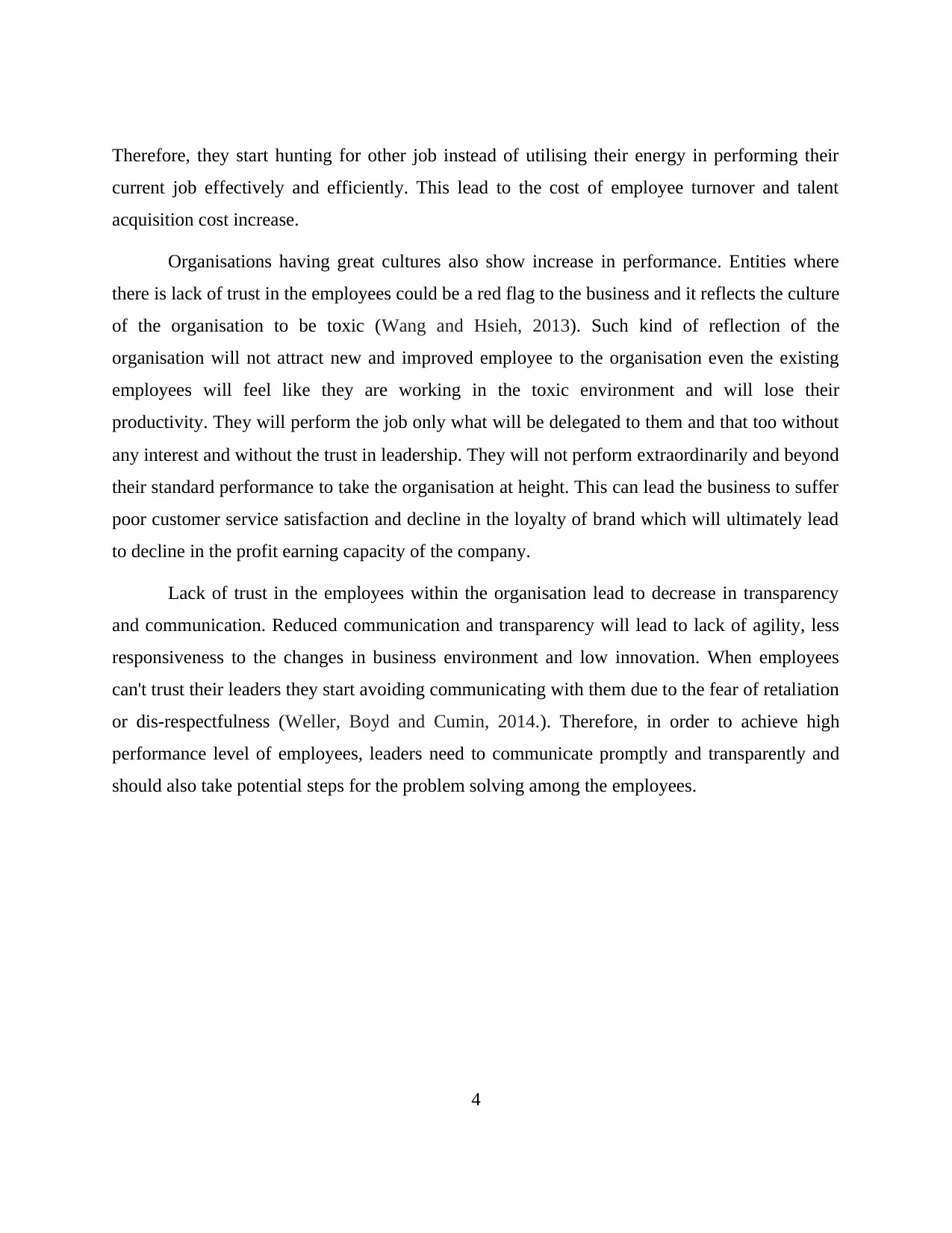
Therefore, they start hunting for other job instead of utilising their energy in performing their
current job effectively and efficiently. This lead to the cost of employee turnover and talent
acquisition cost increase.
Organisations having great cultures also show increase in performance. Entities where
there is lack of trust in the employees could be a red flag to the business and it reflects the culture
of the organisation to be toxic (Wang and Hsieh, 2013). Such kind of reflection of the
organisation will not attract new and improved employee to the organisation even the existing
employees will feel like they are working in the toxic environment and will lose their
productivity. They will perform the job only what will be delegated to them and that too without
any interest and without the trust in leadership. They will not perform extraordinarily and beyond
their standard performance to take the organisation at height. This can lead the business to suffer
poor customer service satisfaction and decline in the loyalty of brand which will ultimately lead
to decline in the profit earning capacity of the company.
Lack of trust in the employees within the organisation lead to decrease in transparency
and communication. Reduced communication and transparency will lead to lack of agility, less
responsiveness to the changes in business environment and low innovation. When employees
can't trust their leaders they start avoiding communicating with them due to the fear of retaliation
or dis-respectfulness (Weller, Boyd and Cumin, 2014.). Therefore, in order to achieve high
performance level of employees, leaders need to communicate promptly and transparently and
should also take potential steps for the problem solving among the employees.
4
current job effectively and efficiently. This lead to the cost of employee turnover and talent
acquisition cost increase.
Organisations having great cultures also show increase in performance. Entities where
there is lack of trust in the employees could be a red flag to the business and it reflects the culture
of the organisation to be toxic (Wang and Hsieh, 2013). Such kind of reflection of the
organisation will not attract new and improved employee to the organisation even the existing
employees will feel like they are working in the toxic environment and will lose their
productivity. They will perform the job only what will be delegated to them and that too without
any interest and without the trust in leadership. They will not perform extraordinarily and beyond
their standard performance to take the organisation at height. This can lead the business to suffer
poor customer service satisfaction and decline in the loyalty of brand which will ultimately lead
to decline in the profit earning capacity of the company.
Lack of trust in the employees within the organisation lead to decrease in transparency
and communication. Reduced communication and transparency will lead to lack of agility, less
responsiveness to the changes in business environment and low innovation. When employees
can't trust their leaders they start avoiding communicating with them due to the fear of retaliation
or dis-respectfulness (Weller, Boyd and Cumin, 2014.). Therefore, in order to achieve high
performance level of employees, leaders need to communicate promptly and transparently and
should also take potential steps for the problem solving among the employees.
4
⊘ This is a preview!⊘
Do you want full access?
Subscribe today to unlock all pages.

Trusted by 1+ million students worldwide
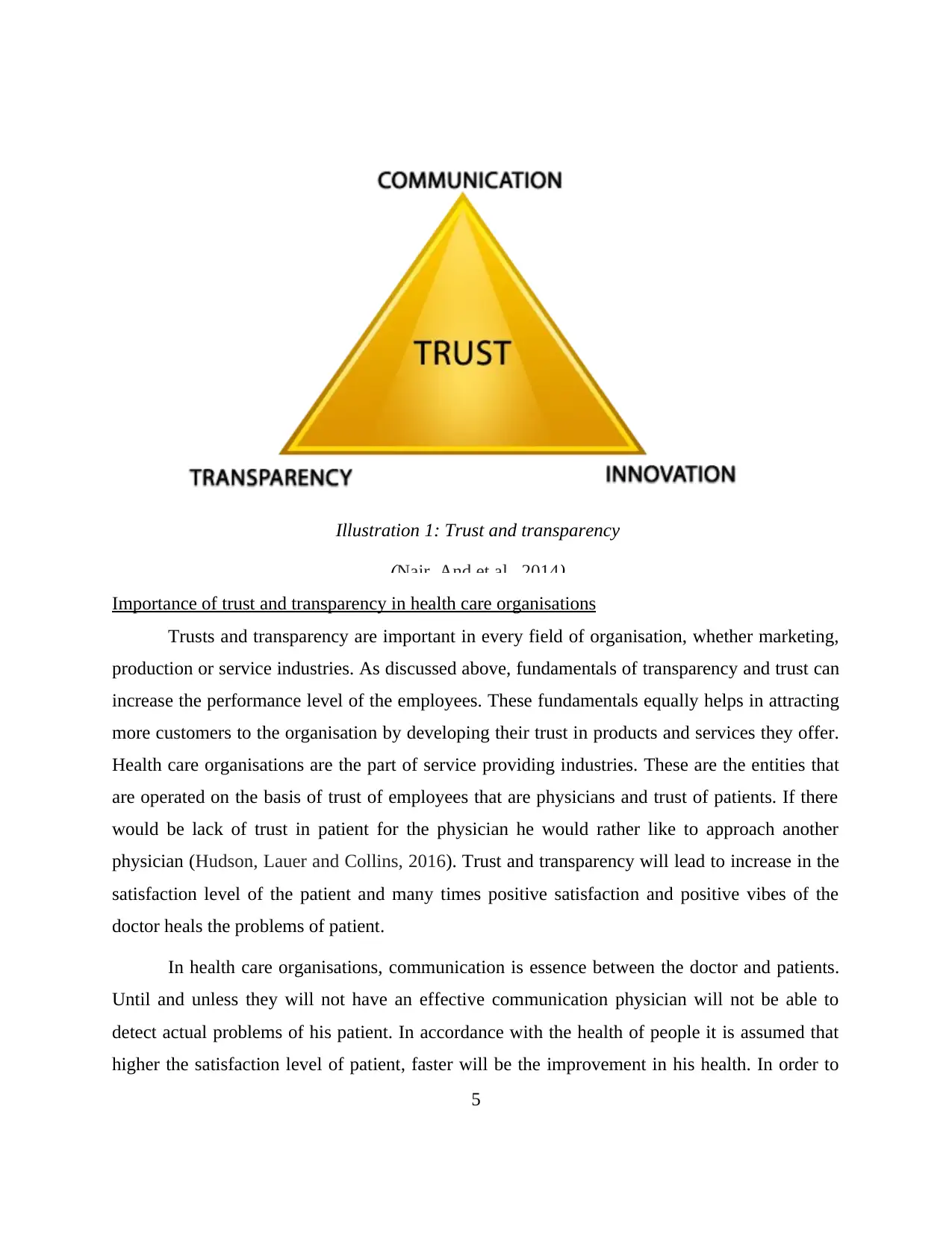
Illustration 1: Trust and transparency
(Nair, And et.al., 2014)
Importance of trust and transparency in health care organisations
Trusts and transparency are important in every field of organisation, whether marketing,
production or service industries. As discussed above, fundamentals of transparency and trust can
increase the performance level of the employees. These fundamentals equally helps in attracting
more customers to the organisation by developing their trust in products and services they offer.
Health care organisations are the part of service providing industries. These are the entities that
are operated on the basis of trust of employees that are physicians and trust of patients. If there
would be lack of trust in patient for the physician he would rather like to approach another
physician (Hudson, Lauer and Collins, 2016). Trust and transparency will lead to increase in the
satisfaction level of the patient and many times positive satisfaction and positive vibes of the
doctor heals the problems of patient.
In health care organisations, communication is essence between the doctor and patients.
Until and unless they will not have an effective communication physician will not be able to
detect actual problems of his patient. In accordance with the health of people it is assumed that
higher the satisfaction level of patient, faster will be the improvement in his health. In order to
5
(Nair, And et.al., 2014)
Importance of trust and transparency in health care organisations
Trusts and transparency are important in every field of organisation, whether marketing,
production or service industries. As discussed above, fundamentals of transparency and trust can
increase the performance level of the employees. These fundamentals equally helps in attracting
more customers to the organisation by developing their trust in products and services they offer.
Health care organisations are the part of service providing industries. These are the entities that
are operated on the basis of trust of employees that are physicians and trust of patients. If there
would be lack of trust in patient for the physician he would rather like to approach another
physician (Hudson, Lauer and Collins, 2016). Trust and transparency will lead to increase in the
satisfaction level of the patient and many times positive satisfaction and positive vibes of the
doctor heals the problems of patient.
In health care organisations, communication is essence between the doctor and patients.
Until and unless they will not have an effective communication physician will not be able to
detect actual problems of his patient. In accordance with the health of people it is assumed that
higher the satisfaction level of patient, faster will be the improvement in his health. In order to
5
Paraphrase This Document
Need a fresh take? Get an instant paraphrase of this document with our AI Paraphraser
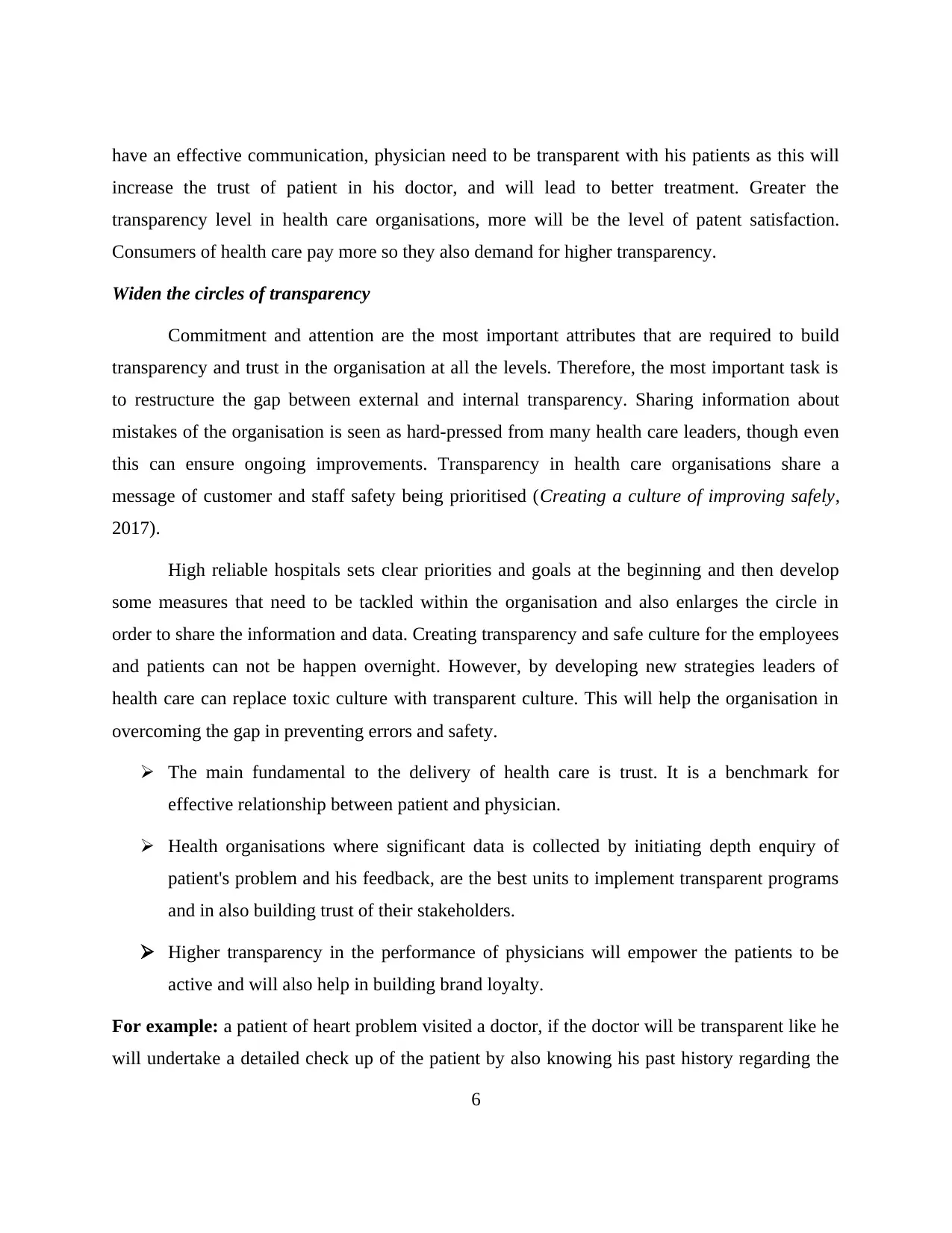
have an effective communication, physician need to be transparent with his patients as this will
increase the trust of patient in his doctor, and will lead to better treatment. Greater the
transparency level in health care organisations, more will be the level of patent satisfaction.
Consumers of health care pay more so they also demand for higher transparency.
Widen the circles of transparency
Commitment and attention are the most important attributes that are required to build
transparency and trust in the organisation at all the levels. Therefore, the most important task is
to restructure the gap between external and internal transparency. Sharing information about
mistakes of the organisation is seen as hard-pressed from many health care leaders, though even
this can ensure ongoing improvements. Transparency in health care organisations share a
message of customer and staff safety being prioritised (Creating a culture of improving safely,
2017).
High reliable hospitals sets clear priorities and goals at the beginning and then develop
some measures that need to be tackled within the organisation and also enlarges the circle in
order to share the information and data. Creating transparency and safe culture for the employees
and patients can not be happen overnight. However, by developing new strategies leaders of
health care can replace toxic culture with transparent culture. This will help the organisation in
overcoming the gap in preventing errors and safety.
The main fundamental to the delivery of health care is trust. It is a benchmark for
effective relationship between patient and physician.
Health organisations where significant data is collected by initiating depth enquiry of
patient's problem and his feedback, are the best units to implement transparent programs
and in also building trust of their stakeholders.
Higher transparency in the performance of physicians will empower the patients to be
active and will also help in building brand loyalty.
For example: a patient of heart problem visited a doctor, if the doctor will be transparent like he
will undertake a detailed check up of the patient by also knowing his past history regarding the
6
increase the trust of patient in his doctor, and will lead to better treatment. Greater the
transparency level in health care organisations, more will be the level of patent satisfaction.
Consumers of health care pay more so they also demand for higher transparency.
Widen the circles of transparency
Commitment and attention are the most important attributes that are required to build
transparency and trust in the organisation at all the levels. Therefore, the most important task is
to restructure the gap between external and internal transparency. Sharing information about
mistakes of the organisation is seen as hard-pressed from many health care leaders, though even
this can ensure ongoing improvements. Transparency in health care organisations share a
message of customer and staff safety being prioritised (Creating a culture of improving safely,
2017).
High reliable hospitals sets clear priorities and goals at the beginning and then develop
some measures that need to be tackled within the organisation and also enlarges the circle in
order to share the information and data. Creating transparency and safe culture for the employees
and patients can not be happen overnight. However, by developing new strategies leaders of
health care can replace toxic culture with transparent culture. This will help the organisation in
overcoming the gap in preventing errors and safety.
The main fundamental to the delivery of health care is trust. It is a benchmark for
effective relationship between patient and physician.
Health organisations where significant data is collected by initiating depth enquiry of
patient's problem and his feedback, are the best units to implement transparent programs
and in also building trust of their stakeholders.
Higher transparency in the performance of physicians will empower the patients to be
active and will also help in building brand loyalty.
For example: a patient of heart problem visited a doctor, if the doctor will be transparent like he
will undertake a detailed check up of the patient by also knowing his past history regarding the
6
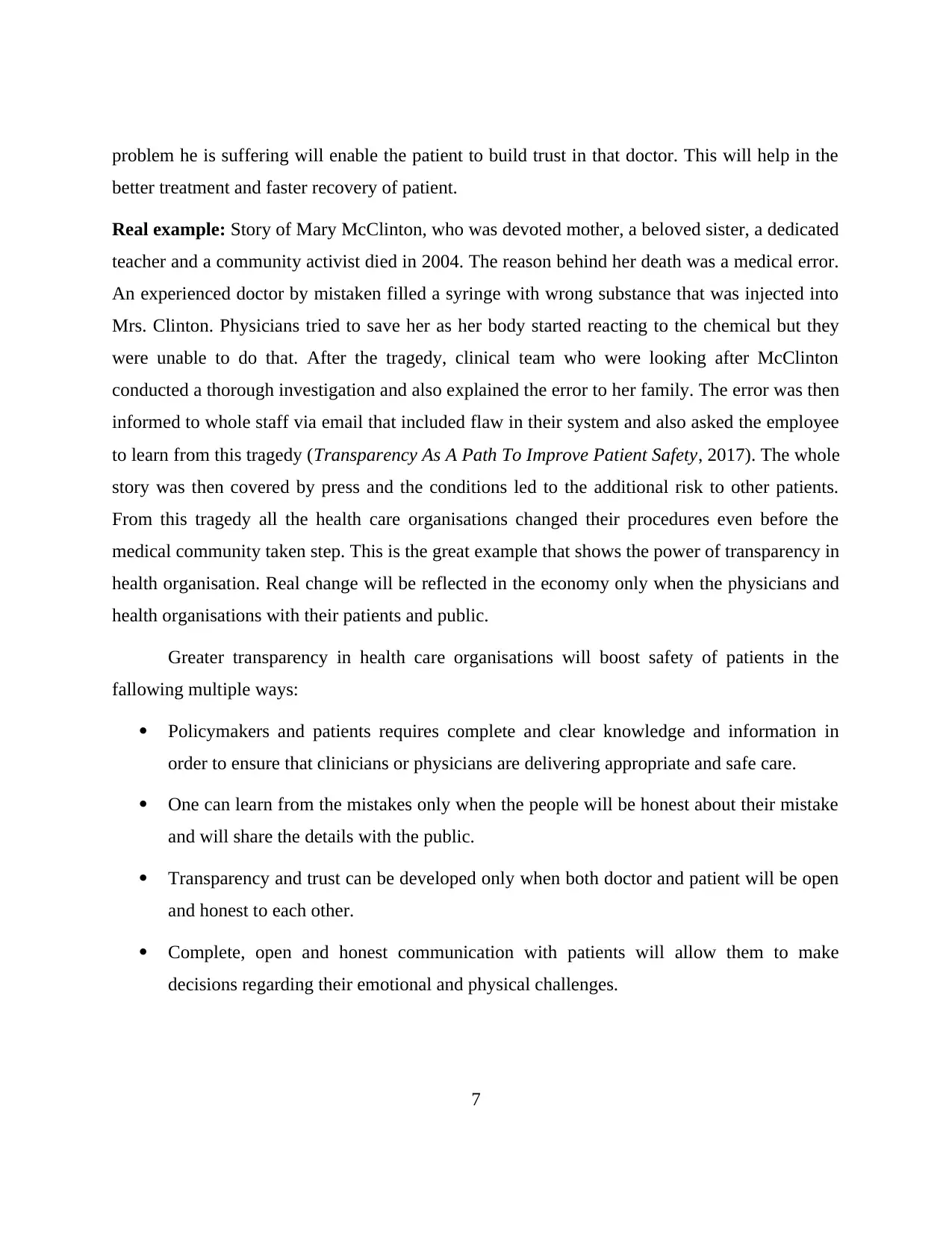
problem he is suffering will enable the patient to build trust in that doctor. This will help in the
better treatment and faster recovery of patient.
Real example: Story of Mary McClinton, who was devoted mother, a beloved sister, a dedicated
teacher and a community activist died in 2004. The reason behind her death was a medical error.
An experienced doctor by mistaken filled a syringe with wrong substance that was injected into
Mrs. Clinton. Physicians tried to save her as her body started reacting to the chemical but they
were unable to do that. After the tragedy, clinical team who were looking after McClinton
conducted a thorough investigation and also explained the error to her family. The error was then
informed to whole staff via email that included flaw in their system and also asked the employee
to learn from this tragedy (Transparency As A Path To Improve Patient Safety, 2017). The whole
story was then covered by press and the conditions led to the additional risk to other patients.
From this tragedy all the health care organisations changed their procedures even before the
medical community taken step. This is the great example that shows the power of transparency in
health organisation. Real change will be reflected in the economy only when the physicians and
health organisations with their patients and public.
Greater transparency in health care organisations will boost safety of patients in the
fallowing multiple ways:
Policymakers and patients requires complete and clear knowledge and information in
order to ensure that clinicians or physicians are delivering appropriate and safe care.
One can learn from the mistakes only when the people will be honest about their mistake
and will share the details with the public.
Transparency and trust can be developed only when both doctor and patient will be open
and honest to each other.
Complete, open and honest communication with patients will allow them to make
decisions regarding their emotional and physical challenges.
7
better treatment and faster recovery of patient.
Real example: Story of Mary McClinton, who was devoted mother, a beloved sister, a dedicated
teacher and a community activist died in 2004. The reason behind her death was a medical error.
An experienced doctor by mistaken filled a syringe with wrong substance that was injected into
Mrs. Clinton. Physicians tried to save her as her body started reacting to the chemical but they
were unable to do that. After the tragedy, clinical team who were looking after McClinton
conducted a thorough investigation and also explained the error to her family. The error was then
informed to whole staff via email that included flaw in their system and also asked the employee
to learn from this tragedy (Transparency As A Path To Improve Patient Safety, 2017). The whole
story was then covered by press and the conditions led to the additional risk to other patients.
From this tragedy all the health care organisations changed their procedures even before the
medical community taken step. This is the great example that shows the power of transparency in
health organisation. Real change will be reflected in the economy only when the physicians and
health organisations with their patients and public.
Greater transparency in health care organisations will boost safety of patients in the
fallowing multiple ways:
Policymakers and patients requires complete and clear knowledge and information in
order to ensure that clinicians or physicians are delivering appropriate and safe care.
One can learn from the mistakes only when the people will be honest about their mistake
and will share the details with the public.
Transparency and trust can be developed only when both doctor and patient will be open
and honest to each other.
Complete, open and honest communication with patients will allow them to make
decisions regarding their emotional and physical challenges.
7
⊘ This is a preview!⊘
Do you want full access?
Subscribe today to unlock all pages.

Trusted by 1+ million students worldwide
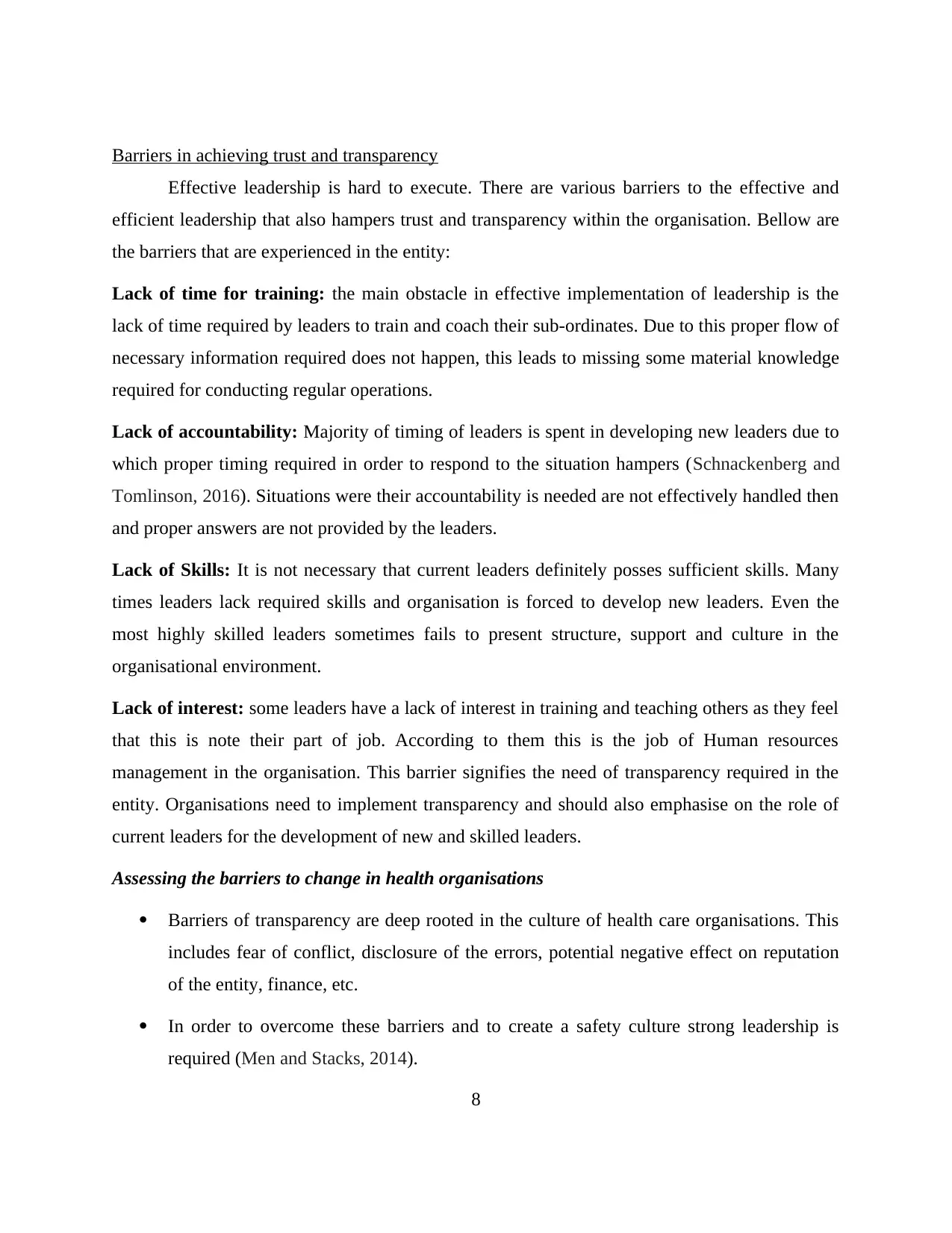
Barriers in achieving trust and transparency
Effective leadership is hard to execute. There are various barriers to the effective and
efficient leadership that also hampers trust and transparency within the organisation. Bellow are
the barriers that are experienced in the entity:
Lack of time for training: the main obstacle in effective implementation of leadership is the
lack of time required by leaders to train and coach their sub-ordinates. Due to this proper flow of
necessary information required does not happen, this leads to missing some material knowledge
required for conducting regular operations.
Lack of accountability: Majority of timing of leaders is spent in developing new leaders due to
which proper timing required in order to respond to the situation hampers (Schnackenberg and
Tomlinson, 2016). Situations were their accountability is needed are not effectively handled then
and proper answers are not provided by the leaders.
Lack of Skills: It is not necessary that current leaders definitely posses sufficient skills. Many
times leaders lack required skills and organisation is forced to develop new leaders. Even the
most highly skilled leaders sometimes fails to present structure, support and culture in the
organisational environment.
Lack of interest: some leaders have a lack of interest in training and teaching others as they feel
that this is note their part of job. According to them this is the job of Human resources
management in the organisation. This barrier signifies the need of transparency required in the
entity. Organisations need to implement transparency and should also emphasise on the role of
current leaders for the development of new and skilled leaders.
Assessing the barriers to change in health organisations
Barriers of transparency are deep rooted in the culture of health care organisations. This
includes fear of conflict, disclosure of the errors, potential negative effect on reputation
of the entity, finance, etc.
In order to overcome these barriers and to create a safety culture strong leadership is
required (Men and Stacks, 2014).
8
Effective leadership is hard to execute. There are various barriers to the effective and
efficient leadership that also hampers trust and transparency within the organisation. Bellow are
the barriers that are experienced in the entity:
Lack of time for training: the main obstacle in effective implementation of leadership is the
lack of time required by leaders to train and coach their sub-ordinates. Due to this proper flow of
necessary information required does not happen, this leads to missing some material knowledge
required for conducting regular operations.
Lack of accountability: Majority of timing of leaders is spent in developing new leaders due to
which proper timing required in order to respond to the situation hampers (Schnackenberg and
Tomlinson, 2016). Situations were their accountability is needed are not effectively handled then
and proper answers are not provided by the leaders.
Lack of Skills: It is not necessary that current leaders definitely posses sufficient skills. Many
times leaders lack required skills and organisation is forced to develop new leaders. Even the
most highly skilled leaders sometimes fails to present structure, support and culture in the
organisational environment.
Lack of interest: some leaders have a lack of interest in training and teaching others as they feel
that this is note their part of job. According to them this is the job of Human resources
management in the organisation. This barrier signifies the need of transparency required in the
entity. Organisations need to implement transparency and should also emphasise on the role of
current leaders for the development of new and skilled leaders.
Assessing the barriers to change in health organisations
Barriers of transparency are deep rooted in the culture of health care organisations. This
includes fear of conflict, disclosure of the errors, potential negative effect on reputation
of the entity, finance, etc.
In order to overcome these barriers and to create a safety culture strong leadership is
required (Men and Stacks, 2014).
8
Paraphrase This Document
Need a fresh take? Get an instant paraphrase of this document with our AI Paraphraser
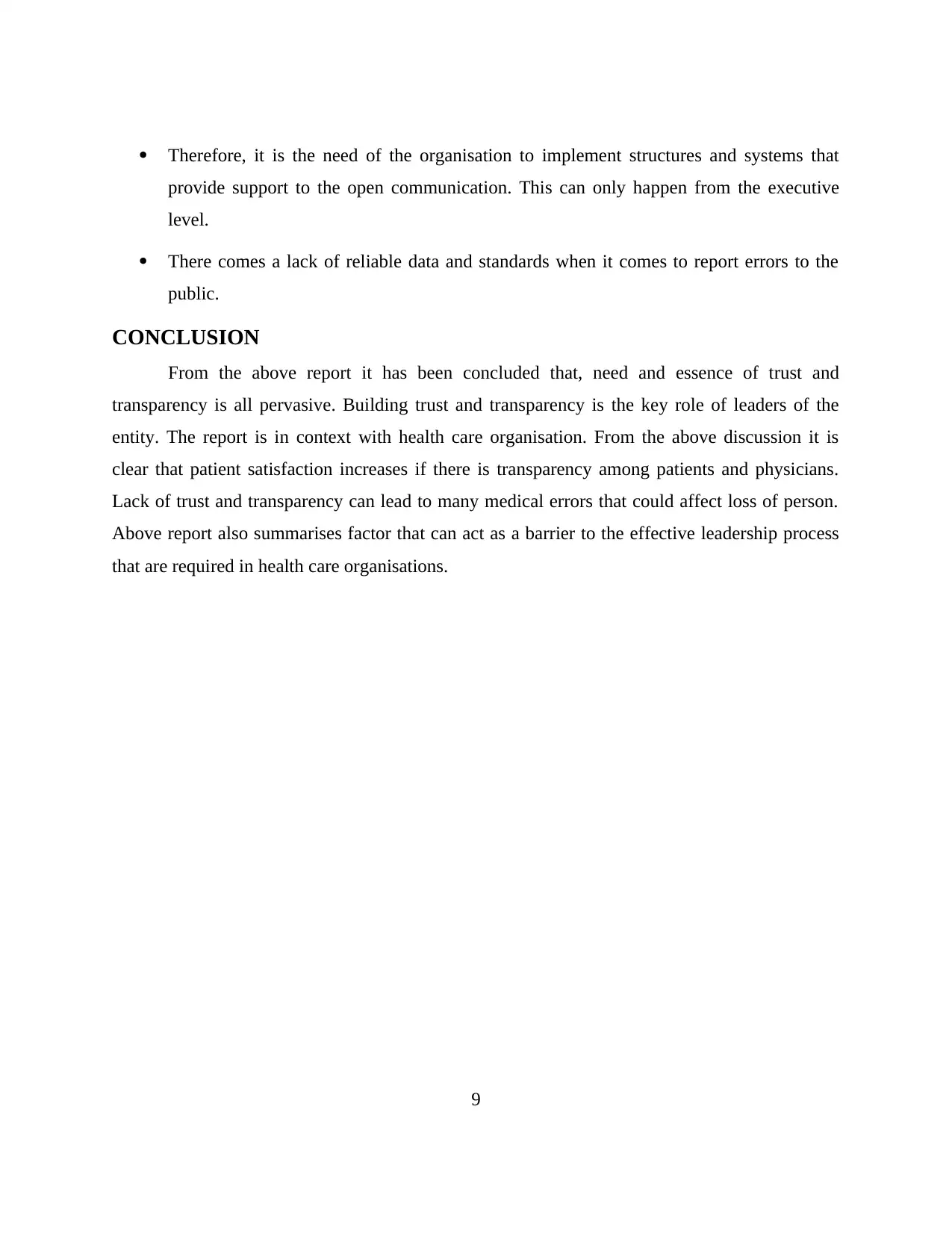
Therefore, it is the need of the organisation to implement structures and systems that
provide support to the open communication. This can only happen from the executive
level.
There comes a lack of reliable data and standards when it comes to report errors to the
public.
CONCLUSION
From the above report it has been concluded that, need and essence of trust and
transparency is all pervasive. Building trust and transparency is the key role of leaders of the
entity. The report is in context with health care organisation. From the above discussion it is
clear that patient satisfaction increases if there is transparency among patients and physicians.
Lack of trust and transparency can lead to many medical errors that could affect loss of person.
Above report also summarises factor that can act as a barrier to the effective leadership process
that are required in health care organisations.
9
provide support to the open communication. This can only happen from the executive
level.
There comes a lack of reliable data and standards when it comes to report errors to the
public.
CONCLUSION
From the above report it has been concluded that, need and essence of trust and
transparency is all pervasive. Building trust and transparency is the key role of leaders of the
entity. The report is in context with health care organisation. From the above discussion it is
clear that patient satisfaction increases if there is transparency among patients and physicians.
Lack of trust and transparency can lead to many medical errors that could affect loss of person.
Above report also summarises factor that can act as a barrier to the effective leadership process
that are required in health care organisations.
9
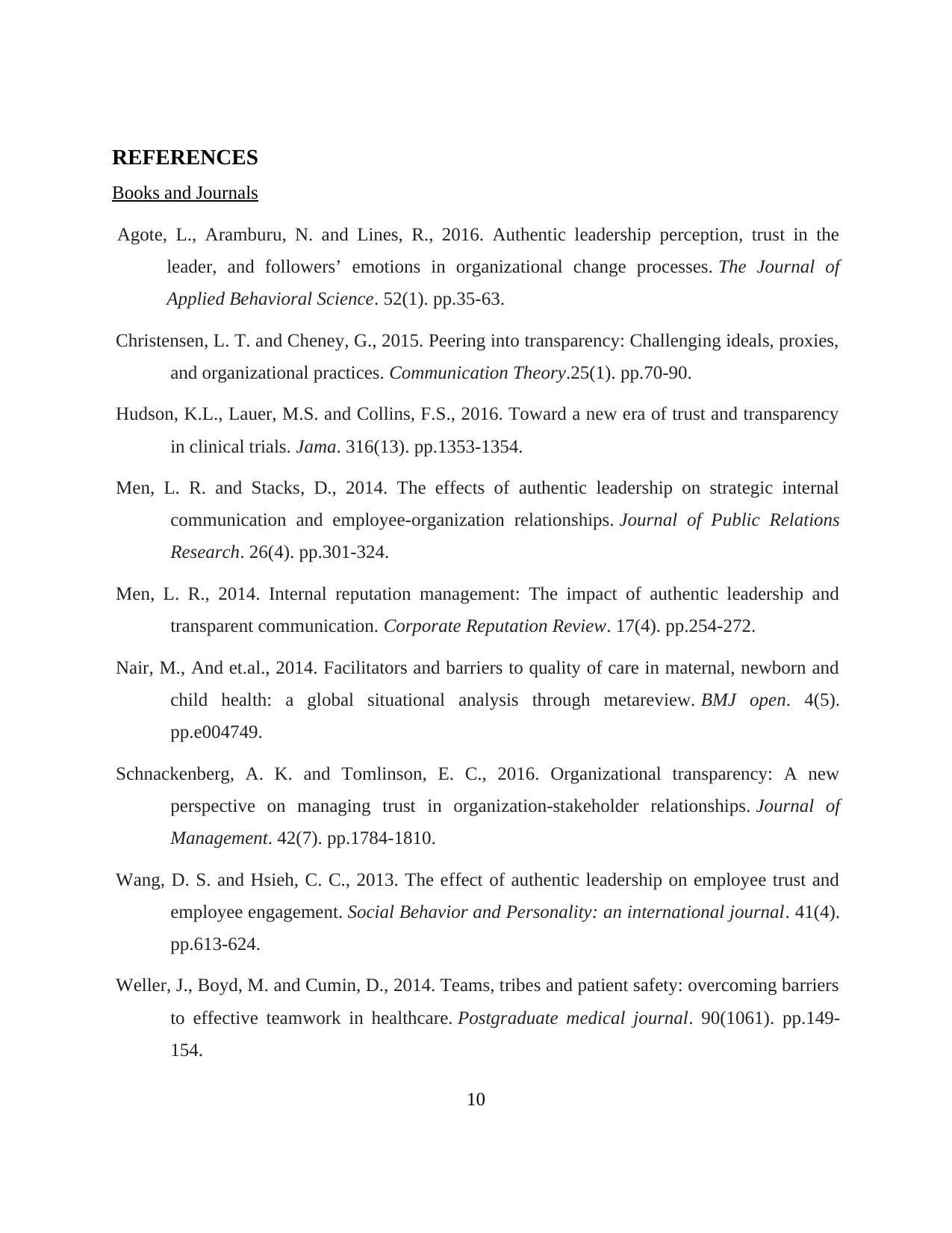
REFERENCES
Books and Journals
Agote, L., Aramburu, N. and Lines, R., 2016. Authentic leadership perception, trust in the
leader, and followers’ emotions in organizational change processes. The Journal of
Applied Behavioral Science. 52(1). pp.35-63.
Christensen, L. T. and Cheney, G., 2015. Peering into transparency: Challenging ideals, proxies,
and organizational practices. Communication Theory.25(1). pp.70-90.
Hudson, K.L., Lauer, M.S. and Collins, F.S., 2016. Toward a new era of trust and transparency
in clinical trials. Jama. 316(13). pp.1353-1354.
Men, L. R. and Stacks, D., 2014. The effects of authentic leadership on strategic internal
communication and employee-organization relationships. Journal of Public Relations
Research. 26(4). pp.301-324.
Men, L. R., 2014. Internal reputation management: The impact of authentic leadership and
transparent communication. Corporate Reputation Review. 17(4). pp.254-272.
Nair, M., And et.al., 2014. Facilitators and barriers to quality of care in maternal, newborn and
child health: a global situational analysis through metareview. BMJ open. 4(5).
pp.e004749.
Schnackenberg, A. K. and Tomlinson, E. C., 2016. Organizational transparency: A new
perspective on managing trust in organization-stakeholder relationships. Journal of
Management. 42(7). pp.1784-1810.
Wang, D. S. and Hsieh, C. C., 2013. The effect of authentic leadership on employee trust and
employee engagement. Social Behavior and Personality: an international journal. 41(4).
pp.613-624.
Weller, J., Boyd, M. and Cumin, D., 2014. Teams, tribes and patient safety: overcoming barriers
to effective teamwork in healthcare. Postgraduate medical journal. 90(1061). pp.149-
154.
10
Books and Journals
Agote, L., Aramburu, N. and Lines, R., 2016. Authentic leadership perception, trust in the
leader, and followers’ emotions in organizational change processes. The Journal of
Applied Behavioral Science. 52(1). pp.35-63.
Christensen, L. T. and Cheney, G., 2015. Peering into transparency: Challenging ideals, proxies,
and organizational practices. Communication Theory.25(1). pp.70-90.
Hudson, K.L., Lauer, M.S. and Collins, F.S., 2016. Toward a new era of trust and transparency
in clinical trials. Jama. 316(13). pp.1353-1354.
Men, L. R. and Stacks, D., 2014. The effects of authentic leadership on strategic internal
communication and employee-organization relationships. Journal of Public Relations
Research. 26(4). pp.301-324.
Men, L. R., 2014. Internal reputation management: The impact of authentic leadership and
transparent communication. Corporate Reputation Review. 17(4). pp.254-272.
Nair, M., And et.al., 2014. Facilitators and barriers to quality of care in maternal, newborn and
child health: a global situational analysis through metareview. BMJ open. 4(5).
pp.e004749.
Schnackenberg, A. K. and Tomlinson, E. C., 2016. Organizational transparency: A new
perspective on managing trust in organization-stakeholder relationships. Journal of
Management. 42(7). pp.1784-1810.
Wang, D. S. and Hsieh, C. C., 2013. The effect of authentic leadership on employee trust and
employee engagement. Social Behavior and Personality: an international journal. 41(4).
pp.613-624.
Weller, J., Boyd, M. and Cumin, D., 2014. Teams, tribes and patient safety: overcoming barriers
to effective teamwork in healthcare. Postgraduate medical journal. 90(1061). pp.149-
154.
10
⊘ This is a preview!⊘
Do you want full access?
Subscribe today to unlock all pages.

Trusted by 1+ million students worldwide
1 out of 13
Related Documents
Your All-in-One AI-Powered Toolkit for Academic Success.
+13062052269
info@desklib.com
Available 24*7 on WhatsApp / Email
![[object Object]](/_next/static/media/star-bottom.7253800d.svg)
Unlock your academic potential
Copyright © 2020–2025 A2Z Services. All Rights Reserved. Developed and managed by ZUCOL.





![[University] Leadership and Management Reflective Essay - [Module]](/_next/image/?url=https%3A%2F%2Fdesklib.com%2Fmedia%2Fimages%2Ffg%2Fc92cbcc5f4dc48e2a67d941cd8fa027d.jpg&w=256&q=75)